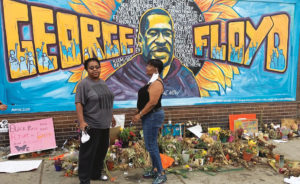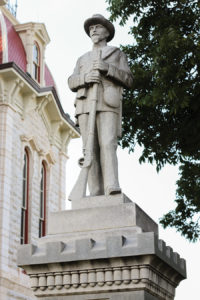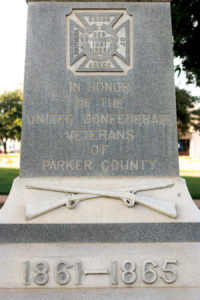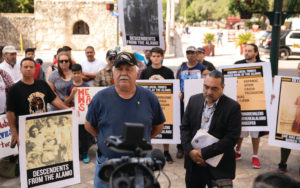The party Demetria McFarland’s family throws every Juneteenth is so big they usually need at least three trailer-size smokers to cook enough food for everyone. McFarland’s brother-in-law invites extended family each year to his home in the rural East Texas countryside near Marshall, and it typically takes several days of work to prepare for the gathering. This year, even with many not attending due to the pandemic, more than 100 people showed up. For the cooks in the family, the party often starts the night before, on June 18.
McFarland, 50, says that people at this year’s party were more somber and reflective than usual.
“Here we are celebrating this day which is supposedly about freedom for Black people, and yet look at what happened to George Floyd,” she says. “ ‘We’re not free because look at how we’re still losing our lives.’ That was kind of the conversation at the barbecue that Friday. ‘We’re celebrating our freedom, but are we really free?’ ”
Conversation easily drifted to Floyd’s death in no small part because the following day, McFarland planned to drive across the country to the spot where Minneapolis police killed him the month before.

Photo courtesy of Demetria McFarland.
McFarland, joined by a sister and niece, drove through the night, making few stops. Upon reaching Minneapolis, they went directly to the block that mourners from across the country had transformed into a public memorial. McFarland saw the streets full of signs and flowers and other evidence that there were more people like her who felt the gravity of the moment.
“There were mounds of flowers that had dried up, just piles of flowers that had faded,” she says. “That’s where a movement happened. A movement took place when he took his last breath.”
As protests against police brutality transformed into a larger reckoning with the nation’s history of racial violence, McFarland looked for ways to bring the movement home to Deep East Texas, a region long plagued by white supremacist violence. She eventually focused her efforts on a marble statue of a Confederate soldier atop a granite pedestal emblazoned with a Confederate flag that has sat outside the county courthouse in Marshall for more than a century, surrounded by restaurants, boutiques, and law offices. She calls it “a symbol of hate” in her hometown and started circulating a petition demanding its removal.
“That statue reminds me of the rape, torture, and dehumanization my ancestors went through,” McFarland says. “It’s boasting of white supremacy. I’m tired of it.”

Photo by Lily Yeargins.
Those demands echo across Texas and the country. Democrats and Republicans in Congress have pushed to strip military bases of Confederate names, including a sprawling military installation in Central Texas named after Confederate Lt. General John Bell Hood. Protests and acts of civil disobedience have underscored the disturbing legacies of even traditionally revered historical figures, such as George Washington and Ulysses S. Grant, who participated in the genocide of Indigenous people and enslaved others. Companies, sports franchises, and universities face increased pressure to drop racist slurs and slogans.
In Weatherford, the Confederate monument at the Parker County courthouse was the site of several clashes between protesters and monument supporters in July, attracting national attention. County commissioners, citing public input, unanimously voted not to remove the monument. In Austin, Democratic lawmakers have called for the removal of tributes to the Confederacy perched around the Capitol and demanded the renaming of the John H. Reagan state office building, named after a top Confederate official who held that African Americans were “incapable of self-government.”
If successful, the push to acknowledge a history of violent racism could change the way Texans remember their history and the memorials, monuments, and names that make up the image cultivated by the Lone Star State.
“Today, we find ourselves at a crossroads,” the Texas lawmakers wrote in July. “Will we situate ourselves on the right side of history by removing these symbols of hostility, or will we continue to side with ‘tradition’ and ignore the ills of our past?”
*****
Formerly enslaved people in Texas were denied political power for years, even after General Gordon Granger famously marched his Union occupation force into Galveston on June 19, 1865, to deliver news of emancipation.

The state constitution drafted after the end of the Civil War in 1866 denied equality to freedmen in Texas, prohibiting them from voting, holding public office, or serving on juries. Those rights came only after Congress intervened through a series of Reconstruction Acts in the following years. In 1868, the first year freedmen could cast a ballot in Texas, 10 Black men were elected to serve as delegates to the next Constitutional convention. In the next state election, African Americans were elevated to the Texas Legislature for the first time — 12 House members and two senators, most of whom had survived slavery.
Merline Pitre, a scholar of Reconstruction and African-American history at Texas Southern University, says many of the priorities for Black lawmakers in those first years after slavery still resonate today: They pushed for public education and voting rights while fighting against labor exploitation, the redrawing of district lines to reduce Black voting power, and the segregation of public services and accommodations such as railroad coaches.
“These are problems we would face for generations,” Pitre says. “Some of them, like voting and gerrymandering, we’re still dealing with.”
Demetria McFarland’s hometown of Marshall became a center of Black political power in the state in the years after emancipation, producing some of Texas’ first African-American lawmakers. Meshack Roberts, who was born into slavery in Arkansas, moved to Marshall after he was freed and was later elected to represent Harrison County in the Texas Legislature in 1872. Roberts, who became a local minister in Marshall, ultimately helped establish Wiley College. David Abner similarly moved to Marshall, in 1866, after being freed from slavery and became a prosperous farmer who later served in the state Legislature and helped found Bishop College, another historically Black institution of higher learning in the city.
Throughout Reconstruction in Texas, Black voters and officials alike faced retaliation and reprisals for accessing their rights or seeking financial independence from people who once enslaved them. White Southerners sought to preserve the old racial order through violence and intimidation: Freedmen’s Bureau records from the time show that African Americans across Texas were threatened, attacked, and killed for voting, challenging an employer, or even socializing in public.
In 1878, after the federal government pulled the last troops out of the South, effectively ending Reconstruction, white Democrats seized power in Harrison County through fraud, force, and coercion. They established an all-white primary process to exclude African Americans from local politics. Parties across the state eventually adopted all-white primaries, which, like poll taxes, soon became a new favored method of voter suppression. Black representation in the Texas Legislature dwindled and then disappeared by the end of the 19th century. Nearly seven decades would pass without an African American serving in the Legislature.
By the early 1900s, monuments to the Confederacy proliferated across Texas and the rest of the South, as did Jim Crow laws designed to disenfranchise Black Americans — both visual and legal reminders that Reconstruction had failed. In 1903, a mob of several hundred white men stormed the jail in Marshall and lynched Walter Davis, a Black man accused in the death of a local constable. Two years later, in 1905, the Marshall chapter of the United Daughters of the Confederacy erected a monument in the town square. Officials dedicated it the following year on Robert E. Lee’s birthday.
In Gainesville, a town of 17,000 an hour north of Dallas, officials installed a pair of Confederate memorials in 1908 and 1911. The statues of lone soldiers went up a generation after a Confederate militia rounded up suspected Union sympathizers there and carried out one of the largest mass hangings in American history. Only recently, and somewhat reluctantly, has the North Texas city begun to acknowledge and memorialize its past. After protests and sit-ins, the city council voted unanimously to pull one of the statues down. The second statue is still standing a mile away. Etched below the figure are the words, “No nation rose so white and fair, None fell so free of crime.”
“I think a lot about the people who have worked in that courthouse,” says Torrey Henderson, one of the local citizens working to tear down the monuments. “How can you walk past those words every single day and never go, ‘You know what? Maybe this isn’t right?’ ”
Henderson and others, who continued to protest throughout the summer near the monument that still stands outside the local courthouse, say officials have tried to intimidate them with arrest warrants and high bail for walking in the street during demonstrations.
******
Since 2015, following the church massacre in Charleston, South Carolina, and the violent white supremacist protests in Charlottesville, Virginia, Texas officials have removed more Confederate monuments and markers than any other state. One of them was a plaque installed inside the Capitol in 1959, during the civil rights era, perpetuating the lie that the South didn’t fight the Civil War to preserve slavery. In 2019, legislation filed by Republican state Senator Brandon Creighton to make it more difficult to scrub Confederate iconography from public places in the state drew emotional testimony from Black lawmakers. (The bill passed the Senate but died in the House.) During a floor debate, Democratic state Senator Royce West pointed to a 9-foot-tall painting of a Confederate general that hangs in the Senate chamber. “Look over my shoulder,” he told the bill’s supporters. “Every day that I come into this chamber I’m reminded of the Confederacy.”

Photo courtesy of Facebook.
San Antonio was one of several cities in Texas where officials pulled down Confederate monuments and stripped schools of their Confederate names and mascots following Charlottesville, but the movement isn’t contained to just Confederate symbols, either. This past July, after protests once again focused attention on a Christopher Columbus statue that Indigenous activists in San Antonio have tried to remove for decades, the city took it down. San Antonio College announced later that month that it would drop the school’s “Ranger” mascot, part of a growing acknowledgement of the Texas Rangers’ legacy of racial violence.
Historians who study the country’s racist roots say there’s never before been such a widespread conversation over the nation’s collective memory as we’ve seen in the past five years, but in San Antonio, efforts to revamp the Alamo could test the limits of the movement in Texas.
Some of the earliest depictions of the mythologized 1836 battle at the Alamo were racialized, including a 1905 painting of shadowy, faceless Mexican troops that hangs in the state Capitol. The oldest surviving film about the Alamo, produced by D.W. Griffith, portrays Mexicans as a threat to white women, the same racist framing Griffith used to depict African Americans in his best-known film from the era, The Birth of a Nation.
Raúl Ramos, a historian and professor at the University of Houston, argues that the popular story of the Alamo — a 13-day siege that ended in the massacre of outmatched anti-federalists by soldiers from Mexico — has largely functioned as a tool for emphasizing a certain racial order, marginalizing Mexican and Indigenous people who lived at the site for more than a century before the battle. Ramos says the popularized story of the Alamo also omits slavery as an animating force in the larger story of Texas independence. The enslaved population in Texas skyrocketed after it seceded from Mexico, which had abolished slavery.
Ramos sees parallels with the “Lost Cause” narrative that followed the Civil War — that the war wasn’t fought over slavery — and its growing popularity around the time officials erected Confederate monuments across the South. “It essentially covers up the prevailing conflict of the past,” he says.
State and local officials are now overseeing a multimillion-dollar redevelopment project to reconfigure the streets around the Alamo and rehabilitate the grounds, which Ramos calls a unique opportunity to “show what inclusive monuments and historical sites look like.”
Yet recent conflicts with Indigenous communities in and around the city illustrate the continued hurdles. Over the past year, the Tap Pilam Coahuiltecan Nation has filed state and federal lawsuits seeking to be included in the process of handling human remains unearthed during the Alamo Plaza redesign. The tribe’s citizens include descendants and relatives of Mission Indians who lived on the Alamo grounds prior to 1836 and were likely buried there.
Ramón Vásquez, a member of Tap Pilam’s tribal council, says the lawsuits are part of a larger fight to more fully explore the site and its history.
“If we were to change the narrative and showcase the interrelations that were established here,” he says, “maybe we wouldn’t have such a hard time with conversations about race relations today.”
Vásquez remembers the message he came away with after a field trip to the site as a child: As an Indigenous student in a predominantly white class, Vásquez remembers other kids eyeing him with suspicion after touring the battle site and learning about the Mexican hordes who slaughtered the brave Texians.
“I was that fourth grader, that brown child that walked away from there with his tail tucked between his legs,” Vásquez says. “How many more children went through that?”
*****
In Marshall, the fight for equality has been hard and long. In 1959, fighting segregation and disenfranchisement, students and professors at local colleges established by some of Texas’ first African-American lawmakers launched a campaign for desegregation. They recruited students at both Bishop and Wiley colleges to train them on sit-in tactics. The following year, Martin Luther King Jr. delivered a speech at Wiley College about the right to protest. Nine days later, students began a series of sit-ins at the Woolworth’s lunch counter downtown.
The backlash was intense. Police arrested dozens of students and trained high-pressure water hoses on others who protested in front of the courthouse by singing songs. Large crowds of white people, some with attack dogs, showed up in town to intimidate the protesters. Then Gov. Price Daniel ordered an investigation into the supposed Communist ties of a professor who helped organize the sit-ins. The professor, Doxey Wilkerson, was fired. Downtown businesses rejected integration by removing all lunch counters for the next three decades.
Demetria McFarland considers her petition to take down the Confederate monument in Marshall to be the latest iteration of an old struggle. The removal of the statue, which has symbolized racial oppression for more than a century, would be a sign that her son may grow up in a different world than she did.
“It would help us to heal and look forward to the next generation that won’t be bound by systemic racism and hate because of skin color,” she says.
The protests to take down monuments have also triggered an ugly backlash in places like Marshall. As McFarland tried to topple the Confederate statue outside the old Harrison County courthouse, another local woman started circulating her own petition seeking to save it and “preserve history.” It sparked a counterprotest when McFarland and others led a demonstration outside the courthouse on July 4. One monument defender referred to McFarland’s effort as “statue genocide.”
Tasha Williams, who protested with McFarland that day, says people drove by the site, yelling racial slurs at her and other demonstrators. She reported at least two instances to local police where white men in trucks threatened to kill her while flashing guns. Williams remembers one of them telling her, “How about I relocate your Black ass today?” Her car has been scratched up so many times since the protest that she suspects it’s vandalism and recently changed her license plates. She now has trouble sleeping.
Williams sees the racist threats as a more explicit version of the message the statue has been sending to African Americans in Marshall for more than a century.
“It’s a reminder to Blacks to stay in your place,” she says. “That’s what they’re telling me now. It’s the same thing that statue is saying to me.”
This article was originally published by the , a nonprofit investigative news outlet. Sign up for their weekly newsletter, or follow them on Facebook and Twitter.












